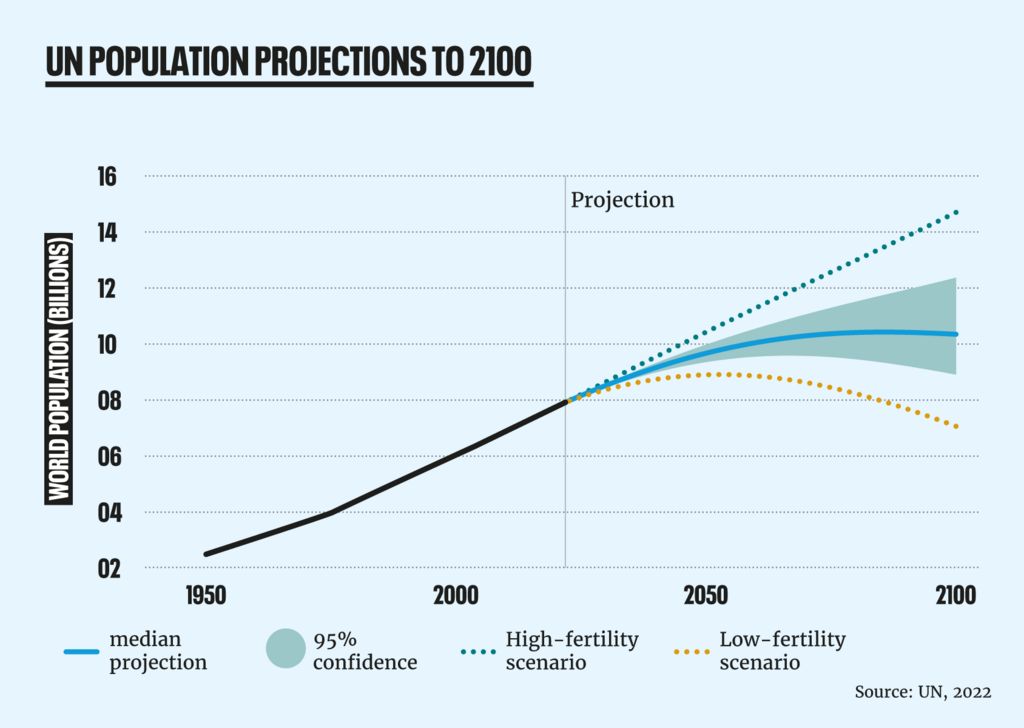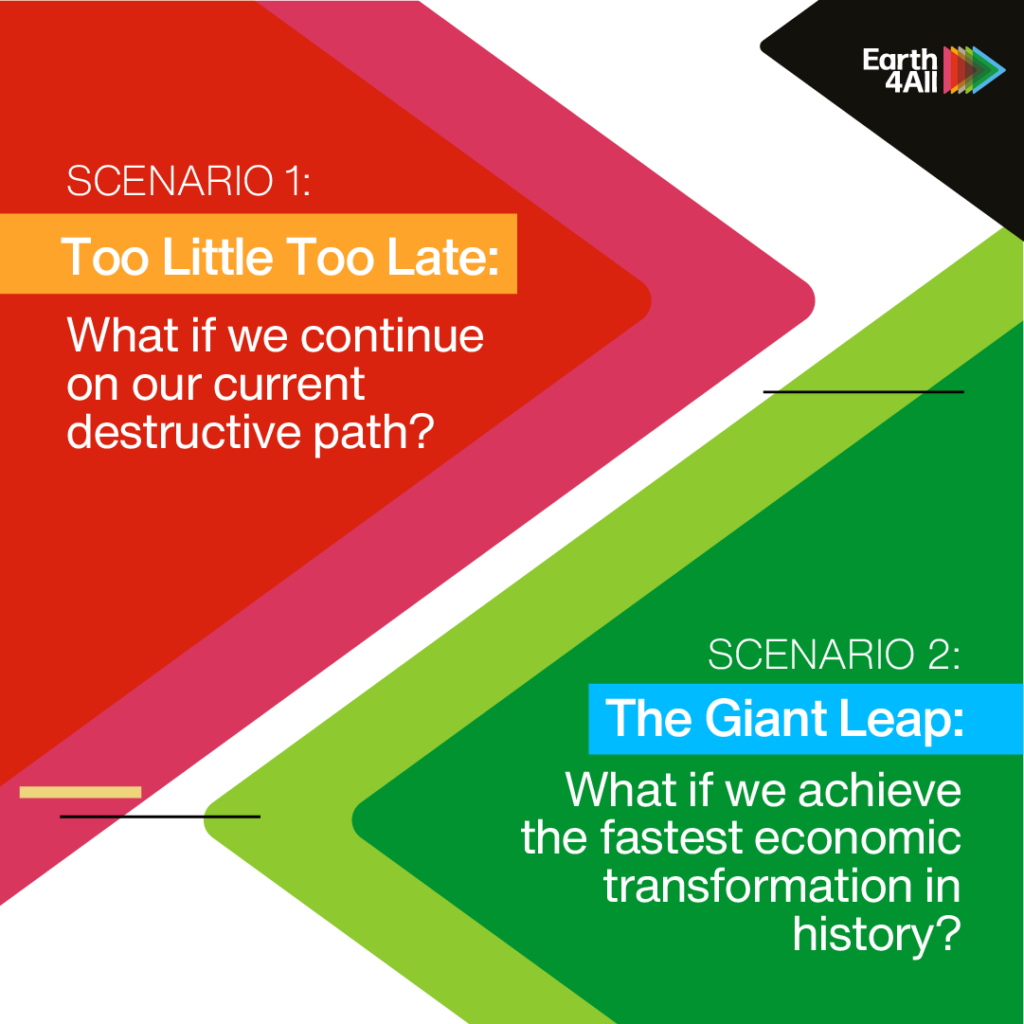
Sustainable population: the Earth4All approach
Earth4All’s recent People and Planet report is the latest attempt at modelling sustainable population projections through the 21st century. It caused a number of exaggerated newspaper headlines, but are its projections of a significant fall in population by 2100 plausible?
The release of a new report caused a bit of a stir at the end of March. The Guardian’s headline ran “World ‘population bomb’ may never go off as feared, finds study”, and many people took to Twitter to ask questions along the lines of, “What were you worried about?”.
While Twitter is probably not your first port of call for reasoned debate and nuanced opinion, just what was all the fuss about?
What is the “ideal” population size?
The question of what population size is environmentally sustainable has been addressed multiple times. While estimates have ranged from as low as 100 million, the most frequently occurring figure is 2-3 billion. Others have taken a different approach and posed the question of whether a good life could be provided to all within planetary boundaries. They show that while only the basic needs of 7 billion could be met currently, by implementing significant changes in social and technical provisioning systems and shifting consumption towards sufficiency, a good life for the same number of people could be sustained.
All previous interrogations of sustainable population have treated population itself as a factor determined independently of other social and environmental dynamics and have largely relied on the population projections generated by the United Nations Population Division (UNPD).

the Earth4All Analysis
This most recent attempt to address the question of sustainable population comes from the Earth4All (E4A), “an international initiative to accelerate the systems-change we need for an equitable future on a finite planet”. Specifically, E4A’s working paper addresses questions posed by the Swedish non-profit Global Challenges Foundation (GCF) around the number of people that the Earth might sustain at different levels of welfare, changes in technology and resource management.
The E4A explore the GCF’s questions under two contrasting scenarios: Too Little Too Late (TLTL), and the Giant Leap. Unlike other attempts that calculate a figure for an environmentally sustainable population and then compare it with separately modelled population projections, the E4A model combines the two.

Too Little Too Late
Running the TLTL model to the end of this century results in a moderate slowing of global population growth with a peak of just under 9 billion reached by mid-century. Similarly, economic growth somewhat slows but average per capita global incomes continue to increase. However, despite population size reaching a considerably lower peak than that projected by the UN, labour participation rates decline, as does trust in government.
This scenario reflects our current trajectory. What if societies continue at a similar pace, setting incremental goals but failing to take strong collective action? Will we cross irreversible tipping points, threatening the foundations of Earth’s stable climate? Will skyrocketing inequality lead to worsening social tensions?
Earth4All
Moreover, inequality and ecological footprint increases are accompanied by huge losses in wildlife. However, while planetary boundaries are further breached with carbon emissions pushing warming to 2.5ºC by the end of the century, the TLTL model does not anticipate global climate or ecological collapse.
Despite this, E4A predict that under the TLTL model regional societal collapses increase in the decades leading to 2050 as deepening social division within and between societies increase. In particular, countries with poor governance and high ecological vulnerabilities are most at risk.

Giant Leap
In the second scenario, the Giant Leap (GL), E4A sketch out a developmental future where institutions eliminate poverty and substantially reduce the risks from Earth system shocks. Specifically, five key factors are addressed in the GL scenario:
- end poverty
- address gross inequality
- empower women
- create a food system healthy for people and ecosystems
- transition to clean energy
Importantly, it is emphasised that…
These extraordinary turnarounds are designed as policy and investment road maps that will work for the majority of people. They are not an attempt to create some impossible-to-reach utopia; instead, they are an essential foundation for a resilient civilisation on a planet under extraordinary pressure. The world is increasingly recognising that there are sufficient knowledge, funds and technologies in the world to implement them.
People and Planet, pg. 20
However, the GL is optimistic. Under this scenario global population peaks at 8.5 billion in 2040 and declines to 6 billion by 2100. Greenhouse gases continuously fall reaching 90% of their 2020 level by 2050 and global warming is kept below 2ºC above preindustrial levels.
This scenario assumes societies embark on a new path to a sustainable world by 2050. What if we fundamentally reconfigure our economies, energy and food systems so that they work for both people and the planet? Can we avoid the worst of climate change impacts and increase our societies’ resilience to shocks? Will we succeedin ending extreme poverty, guaranteeing everyone a healthy diet and access to qulaity education and healthcare?
Earth4All
Human wellbeing improves considerably under the GL scenario with inequality slowly declining and incomes increasing. All of these improvements are the outcome of significant interventions both within nation-states and between them. To achieve all five turnarounds in the Great Leap scenario, E4A calculate that 2-4% of global GDP will need to be deployed. While this might be obtained via methods such as borrowing or increasing the money supply, E4A advocate increasing taxes for the richest 10% of the global population by between 4-8%.
A question of models
In terms of future population growth under both scenarios, the historically demonstrable negative relationship between birth rates and GDP forms the “causal bedrock” of the E4A model. While acknowledging the multiple factors which affect birth rates, the report argues that GDP can be understood as a proxy for key factors such as education, access to contraception and socio-economic mobility.
Economic growth in low-income countries thus becomes a critical factor in the lowering of birth rates. The authors of the report are aware that their approach is not without difficulties and acknowledge where they have made assumptions.
The simple historical correlation between GDP and fertility reduction is therefore primarily deployed in the interests of modelling simplicity, but the E4A team acknowledge elsewhere the importance of policy interventions specifically aimed at reducing fertility through the improvement of women’s opportunities via provision of education, health and contraception amongst other measures.
The report’s authors are not shy about pinning their own particular colours to the mast when they argue:
According to our results across all simulations for both scenarios, the primary issue is not overpopulation in comparison with available resources, but rather the current (too) high consumption levels among the world’s richest quarter. Or, put even more concisely: humanity’s main problem is distribution rather than population.
People and Planet, pg. 34
Yet, despite this appearing to be entirely inconsistent with research by work by O’Neill et al. (2018) who clearly show that distribution alone cannot provide a good life to all, the conclusion must be viewed within the context of the model.
E4A’s modelling under the GL scenario does not pursue an equal shares approach but attempts to argue for a concerted but gradual transition towards reducing global inequality with the result being the meeting of many of the key social and economic conditions, such as women’s empowerment, education and access to family planning, which lead to lower levels of fertility. The model itself does not focus on lowering fertility per se, rather lower fertility is an unintended consequence of tackling poverty with particular progressive policies.
are the E4A population projections realistic?
As noted above, in the TLTL scenario it is unclear whether climate change has a significant effect on mortality and hence peak population size. Whether this is the case or not, E4A clearly regarded TLTL as the least desirable approach producing the greatest risks in terms of welfare and the stability of the Earth system.
The more desirable GL scenario reduces fertility at a considerable pace as the developmental goals of the model are met, and whether this is considered overly optimistic, the outcome is similar to other models where meeting the contraceptive and education aspirations of the SDGs predicted a population size of 6.29 billion by 2100.

